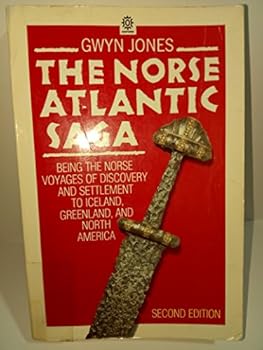The Norse Atlantic Saga: Being the Norse Voyages of Discovery and Settlement to Iceland, Greenland, and North America
Select Format
Select Condition 
Book Overview
The voyages of the Norsemen, or Vikings, across the North Atlantic to Iceland c. 860-70, Greenland c. 986, and the east coast of North America was a turning point in world history and one of the greatest adventures of all time. In Norse Atlantic Saga, Gwyn Jones re-tells the dramatic story of the Viking voyages in vivid, striking prose and includes translations of six classic Viking epics: "The Book os the Icelanders," "The Book of the Settlements", "The Greenlander's Saga", "Eirik the Red's Saga", "Karlsefni's Voyage to Vinland", and "The Story of Einar Sokkason". Published to great acclaim in 1964, The Norse Atlantic Saga is now available in an expanded edition, which takes into account the tremendous gains that have been made in Viking scholarship in the past 22 years: the discrediting of the Vinland Map, greatly extended knowledge of the Vikings' life in Greenland and proof that Norsemen did indeed land and establish a settlement in L'Anse aux Meadows in the New World. For this expanded edition, Jones has largely rewritten his account of the Viking voyages, and added numerous new maps, plates, and illustrations, as well as appendices in which Robert McGhee, Thomas H. McGovern and Brigitta Linderoth Wallace, three prominent archaeologists, discuss their recent findings. The incorporation of this latest research into Gwyn Jones's narrative account of the Viking story guarantees its continued importance to Viking scholars as well as to readers interested in tales of bravery and heroic adventure.
Format:Paperback
Language:English
ISBN:0192851608
ISBN13:9780192851604
Release Date:July 1986
Publisher:Oxford University Press, USA
Length:352 Pages
Weight:0.64 lbs.
Dimensions:0.9" x 5.1" x 7.7"
Customer Reviews
2 ratings
Absorbing -- also includes original major sources
Published by Thriftbooks.com User , 18 years ago
An excellent summary, well told, of what is known about Norse discovery, settlement and developments in Iceland, Greenland, and their farthest overseas reach, North America. Although no one has "the" definitive answers to the mystery of just how, why and exactly when the Norse Greenlanders' Eastern Settlement (really southern) disappeared after enduring for 500 years, Jones examines most of the likely possibilities with discernment in sorting them out. The last definite word we have from Norse Greenland was in 1410 when a group of Icelandic visitors left to return to Iceland after a four-year stay, including a young Greenland woman recently married to one of them. There was little hint of Greenlanders' society being in any threatening decline at that point: although life was not easy, that was nothing new. The best evidence indicates that the last of Greenland's Norse held on at least until the end of the 1400s and more likely well into the 1500s. Theories abound about causes: most propose a combination of factors, but we don't really know. Yes, we do have reports of some violent incidents between Norse and groups of "skraelings" (the Inuit or so-called Eskimo) who had not appeared as far south as the Norse areas until well into the 1300s after more than three centuries of sole Norse settlement there. But there are also reports and evidence of both trade and other friendly and even sheltering contacts. The contacts were limited and infrequent with little or no territorial conflict involved, the Norse living mostly along the inner fjords where there was pasture for their flocks, and the Inuit on the outer coasts where sea hunting was much better. On this, Carl Sauer made a telling comment: "That the unwarlike Eskimos should have driven the Greenlanders back and finally eliminated them by force is quite out of character for both groups." Also the Norwegian Arctic explorer and scientist Fridtjof Nansen, well acquainted with Eskimo culture firsthand, had earlier objected to such claims. (In a recent best-seller Jared Diamond has revived the claim but adduces no new evidence.) There is some evidence of piratic attacks and kidnappings from outside, with English and Basque freebooters and some others suspected, but which without further information remains a dark suspicion unproven to scholars' satisfaction. At any rate it is certain that regular contact with Europe ultimately dried up, and Greenland's "rediscovery" was to wait until the end of the sixteenth century with the Frobisher and Davis expeditions, which found Eskimos but no Norsemen. As for Vinland, Jones gives a good and very interesting account of what is known of those ventures and withdrawal. While rather noncommital as to where the settlement Leif established was located, he inclines toward Helge Ingstad's view that the site he and his wife uncovered at Newfoundland's northern tip is it. (See my other reviews for different opinions on this.) The second half of the book is devoted to th
Summation AND the Original Texts
Published by Thriftbooks.com User , 25 years ago
An excellent book for anyone interested in the Norse explorations of the North Atlantic: Iceland, Greenland, and Vinland. Jones not only gives a good history, still relevant despite the 1964 copyright, but gives the latter half of the book over to English translations of the original sources: The Book of the Icelanders, The Book of the Settlements, The Greenlanders' Saga, Eirik the Red's Saga, Karlsefni's Voyage to Vinland, and The Story of Einar Sokkason.





